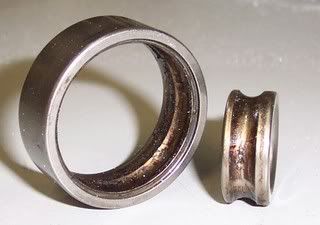klickitatsacket
Addicted to ArboristSite
- Joined
- Dec 3, 2004
- Messages
- 2,051
- Reaction score
- 285
Well by now most every one on here knows that my company is rebuilding bearings and installing ceramics balls. Because we are rebuilding bearings on a fairly regular basis we tend to pay more attention to those things that we never looked closely at before at least not in the same light.
One of the things that I started noticing since we started rebuilding bearings is the amount of oil sludge inside the bearings. The following picture is of a set of races from a 066 bearing. The saw was running when it was taken down for a rebuild. The mix used was 50:1 and the saw had about 800 hours on it.

The reason I am pointing this out is because bearings produce heat from friction and hard run saws over the course of time will burn oil on the races. This in turn builds up sludge and will shorten the life of your bearings and robs horse power.
I am not saying that things are so bad that every one needs to put ceramics in their saw. I would however suggest any one who rebuilds their top end; while you have it off; you might want to use some good parts cleaner or brake clean and wash out their bearings before installing a new top end. Pour it into the case and soak them for a while and then rotate you crank. Do this a couple of times and rinse them out really good. If you are really retentive, maybe even pull your top end down every few hundred hours and wash them out. The last suggestion is for those who do not have a warm girl waiting at home for you.
One of the things that I started noticing since we started rebuilding bearings is the amount of oil sludge inside the bearings. The following picture is of a set of races from a 066 bearing. The saw was running when it was taken down for a rebuild. The mix used was 50:1 and the saw had about 800 hours on it.

The reason I am pointing this out is because bearings produce heat from friction and hard run saws over the course of time will burn oil on the races. This in turn builds up sludge and will shorten the life of your bearings and robs horse power.
I am not saying that things are so bad that every one needs to put ceramics in their saw. I would however suggest any one who rebuilds their top end; while you have it off; you might want to use some good parts cleaner or brake clean and wash out their bearings before installing a new top end. Pour it into the case and soak them for a while and then rotate you crank. Do this a couple of times and rinse them out really good. If you are really retentive, maybe even pull your top end down every few hundred hours and wash them out. The last suggestion is for those who do not have a warm girl waiting at home for you.
























































